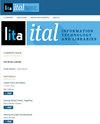使用 Qualtrics XM 创建使用点调查,评估 Primo 本地实施的可用性
IF 1.3
4区 管理学
Q3 COMPUTER SCIENCE, INFORMATION SYSTEMS
引用次数: 0
摘要
2020 年,卡尔加里大学图书馆和文化资源(LCR)使用 Qualtrics XM 设计并试行了一项使用点调查,以收集用户对我们实施 Ex Libris 的网络规模发现服务 Primo 的可用性的反馈意见。在为期两周的时间里,用户在搜索时会看到弹出式调查问卷,并被要求提供反馈意见。本文总结了我们是如何设计和实施这种使用点调查的,以及从这个项目中学到的经验教训。本文章由计算机程序翻译,如有差异,请以英文原文为准。
Using Qualtrics XM to Create a Point-of-Use Survey to Assess the Usability of a Local Implementation of Primo
In 2020, Libraries and Cultural Resources (LCR) at the University of Calgary used Qualtrics XM to design and pilot a point-of-use survey to collect user feedback on the usability of our implementation of Primo, Ex Libris's web-scale discovery service. Over a two-week period, users were presented with the pop-up survey while searching and asked to provide feedback. This article summarizes how we designed and implemented this point-of-use survey and the lessons learned from this project.
求助全文
通过发布文献求助,成功后即可免费获取论文全文。
去求助
来源期刊

Information Technology and Libraries
管理科学-计算机:信息系统
CiteScore
2.90
自引率
5.60%
发文量
25
审稿时长
1 months
期刊介绍:
Information Technology and Libraries publishes original material related to all aspects of information technology in all types of libraries. Topic areas include, but are not limited to, library automation, digital libraries, metadata, identity management, distributed systems and networks, computer security, intellectual property rights, technical standards, geographic information systems, desktop applications, information discovery tools, web-scale library services, cloud computing, digital preservation, data curation, virtualization, search-engine optimization, emerging technologies, social networking, open data, the semantic web, mobile services and applications, usability, universal access to technology, library consortia, vendor relations, and digital humanities.
 求助内容:
求助内容: 应助结果提醒方式:
应助结果提醒方式:


